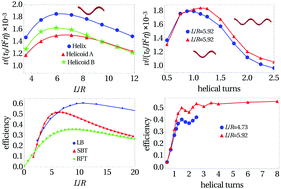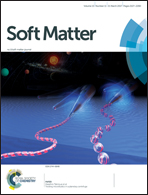Controlled propulsion and separation of helical particles at the nanoscale†
Abstract
Controlling the motion of nano and microscale objects in a fluid environment is a key factor in designing optimized tiny machines that perform mechanical tasks such as transport of drugs or genetic material in cells, fluid mixing to accelerate chemical reactions, and cargo transport in microfluidic chips. Directed motion is made possible by the coupled translational and rotational motion of asymmetric particles. A current challenge in achieving directed and controlled motion at the nanoscale lies in overcoming random Brownian motion due to thermal fluctuations in the fluid. We use a hybrid lattice-Boltzmann molecular dynamics method with full hydrodynamic interactions and thermal fluctuations to demonstrate that controlled propulsion of individual nanohelices in an aqueous environment is possible. We optimize the propulsion velocity and the efficiency of externally driven nanohelices. We quantify the importance of the thermal effects on the directed motion by calculating the Péclet number for various shapes, number of turns and pitch lengths of the helices. Consistent with the experimental microscale separation of chiral objects, our results indicate that in the presence of thermal fluctuations at Péclet numbers >10, chiral particles follow the direction of propagation according to its handedness and the direction of the applied torque making separation of chiral particles possible at the nanoscale. Our results provide criteria for the design and control of helical machines at the nanoscale.



 Please wait while we load your content...
Please wait while we load your content...